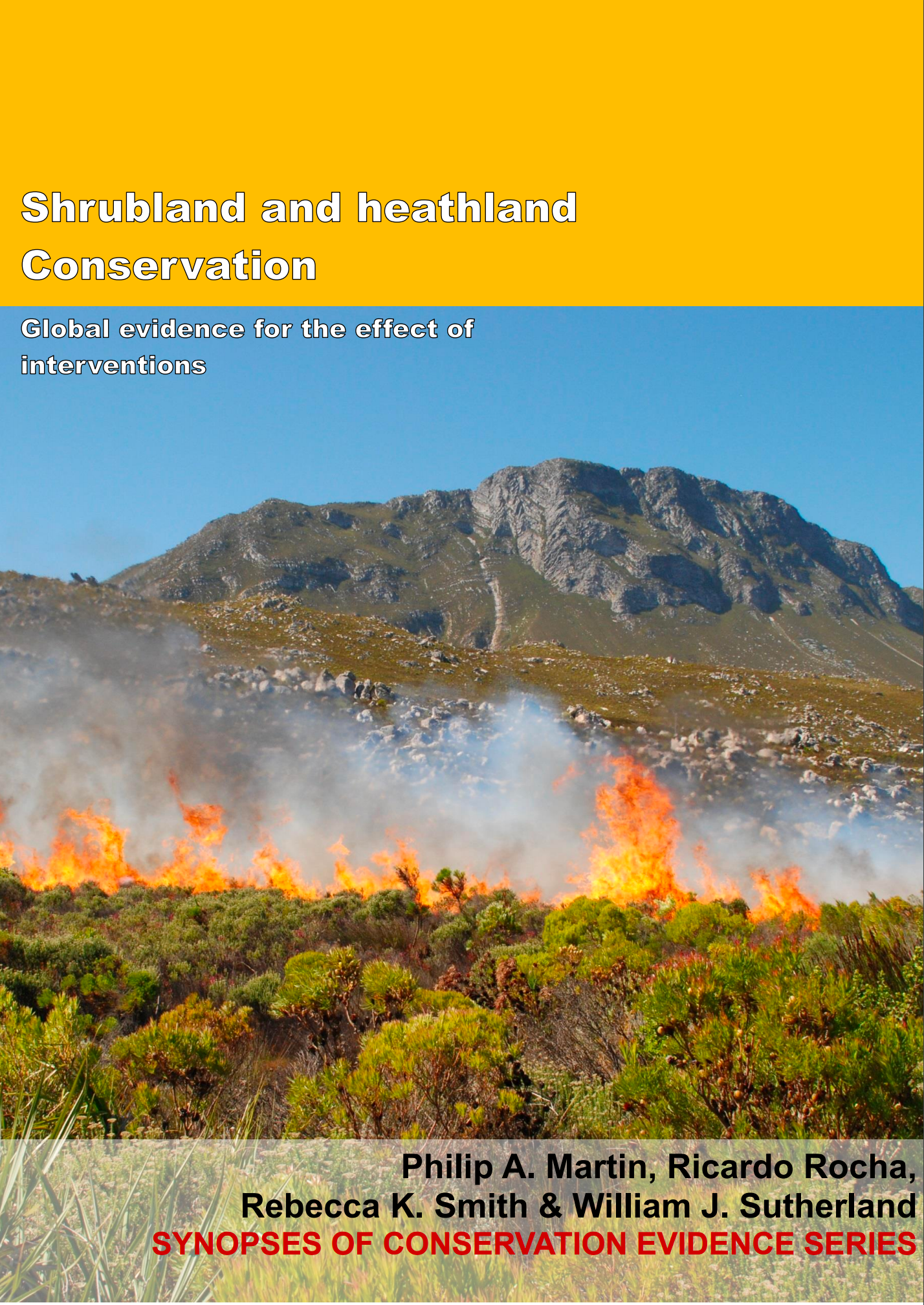Cut and apply herbicide to control bracken
-
Overall effectiveness category Unknown effectiveness (limited evidence)
-
Number of studies: 4
View assessment score
Hide assessment score
How is the evidence assessed?
-
Effectiveness
30% -
Certainty
30% -
Harms
4%
Study locations
Supporting evidence from individual studies
A randomized, controlled study in 1978–1990 in a heathland in Suffolk, UK (Lowday & Marrs 1992) found that spraying with herbicide, followed by annual cutting, reduced the biomass of bracken Pteridium aquilinum, but did not increase heather Calluna vulgaris biomass. After 12 year, bracken biomass was 82–99% lower in areas where bracken had been cut and sprayed with herbicide, than in areas that were not cut or sprayed. In two of nine years heather biomass was higher in areas that had been sprayed with herbicide and cut annually, than in areas that were not sprayed with herbicide and not cut (data presented in log units). In 1978 twelve 18 m2 plots were established. In four plots bracken was sprayed with the herbicide asulam (application rate: 4.4 kg active ingredient/ha) and cut annually in 1978–1990, and in four plots bracken was not cut or sprayed with herbicide. Vegetation cover was assessed every year in three 1 m2 plots which were randomly located in each plot. Vegetation was cut in one 20 cm x 20 cm area in each quadrat and dried to calculate biomass.
Study and other actions testedA randomized, replicated, controlled, paired study in 1993-1995 at a heathland site in Suffolk, UK (Paterson et al. 2000) found that cutting and using herbicide reduced bracken Pteridium aquilinum cover, but had no significant effect on the cover of seven other plant species. In four of four cases bracken cover in areas that were cut and sprayed with herbicide was lower (7-63%) than in areas that were not cut or sprayed (4-12%). The cover of the following plants did not differ significantly in sprayed and cut areas and areas that were not sprayed or cut: common heather Calluna vulgaris (cut and sprayed: 0-2%, unsprayed and uncut: 0%), sedge species Carex spp. (cut and sprayed: 0%, unsprayed and uncut: 1-7%), wavy-hair grass Deschampsia flexuosa (cut and sprayed: 0-14%, unsprayed and uncut: 0-4%), sheep’s fescue Festuca ovina (cut and sprayed: 0% , unsprayed and uncut: 0-5%), Yorkshire fog Holcus lanatus (cut and sprayed: 0%, unsprayed and uncut: 0%), sheep’s sorrel Rumex acetosella (cut and sprayed: 1-13%, unsprayed and uncut: 3-5%), and woodland ragwort Senecio sylvaticus (cut and sprayed: 0%, unsprayed: 0%). Three 8 x 8 m plots were cut and then sprayed with the herbicide asulam in 1993, three plots were spraye with asulam in 1993 and cut in 1994, and three plots were not cut or sprayed. In July 1994 and 1995 plant cover was assessed in two 1 m2 quadrats placed in each plot.
Study and other actions testedA randomized, controlled, before-and-after trial in 1997-2003 in a heathland invaded by bracken Pteridium aquilinum in Norway (Maren et al. 2008) found that annual cutting of bracken and application asulam herbicide increased the cover of heather Calluna vulgaris and reduced cover of bracken. After six years, heather cover in areas where bracken was cut and herbicide applied increased from 2–4% before cutting and application of herbicide to 13–47%, while in plots that were not cut or sprayed with herbicide heather cover remained at approximately 1%. In areas that were cut and treated with herbicide, bracken cover dropped from 75% before cutting and herbicide application to 1–3%, while in areas that were not cut or sprayed with herbicide, bracken cover remained above 75%. Twelve 25 m2 plots were randomly allocated to be either cut and receive herbicide applications of asulam or gratil or remain uncut with no herbicide application. In plots which were cut, bracken was annually cut 20–30 cm above the ground, in July. Three 0.25 m2 quadrats were placed in each plot and used to monitor vegetation cover annually.
Study and other actions testedA replicated, randomized, controlled study in 1993–2003 in three heathland sites in Cannock and the Peak District, UK (Alday et al. 2013) found that cutting bracken Pteridium aquilinum and then spraying asulam increased heathland species richness but spraying asulam and then cutting did not. In plots where bracken was cut and then asulam was applied, species richness was higher ten years after treatment (5.2–8.1) than after one year 4–6.3). However, in plots where bracken was first sprayed and then cut, species richness was lower ten years after treatment (3.1–5.5) than after one year (3.6–6.1). Over the same period species richness decreased in untreated plots (one year after: 3.2–4.9; 10 years after: 2.6–3.9) (data presented as model results). Ten years after treatment, species composition in plots where bracken had been treated was not significantly different from untreated plots (data presented as ordination results). Between six and eighteen 10 x 12 m and 10 x 5 m plots were selected and cutting of bracken and application of herbicide took place between June and August 1993. In one site treatments were repeated in August 1999. Vegetation was monitored annually in June using 1 x 1 m quadrats.
Study and other actions tested
Where has this evidence come from?
List of journals searched by synopsis
All the journals searched for all synopses
This Action forms part of the Action Synopsis:
Shrubland and Heathland Conservation
Shrubland and Heathland Conservation - Published 2017
Shrubland and Heathland synopsis





)_2023.JPG)














